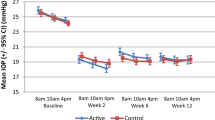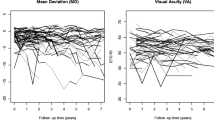Abstract
In some clinical trials and epidemiologic studies, investigators are interested in knowing whether the variability of a biomarker is independently predictive of clinical outcomes. This question is often addressed via a naïve approach where a sample-based estimate (e.g., standard deviation) is calculated as a surrogate for the “true” variability and then used in regression models as a covariate assumed to be free of measurement error. However, it is well known that the measurement error in covariates causes underestimation of the true association. The issue of underestimation can be substantial when the precision is low because of limited number of measures per subject. The joint analysis of survival data and longitudinal data enables one to account for the measurement error in longitudinal data and has received substantial attention in recent years. In this paper we propose a joint model to assess the predictive effect of biomarker variability. The joint model consists of two linked sub-models, a linear mixed model with patient-specific variance for longitudinal data and a full parametric Weibull distribution for survival data, and the association between two models is induced by a latent Gaussian process. Parameters in the joint model are estimated under Bayesian framework and implemented using Markov chain Monte Carlo (MCMC) methods with WinBUGS software. The method is illustrated in the Ocular Hypertension Treatment Study to assess whether the variability of intraocular pressure is an independent risk of primary open-angle glaucoma. The performance of the method is also assessed by simulation studies.
Similar content being viewed by others
References
Bengtsson BL, LeskeMC, Hyman L, Heijl A, Early Manifest Glaucoma Trial Group (2006) Fluctuation of intraocular pressure and glaucoma Progression in the early manifest glaucoma trial. Ophthalmology 114: 205–209
Caprioli J, Coleman AL (2008) Intraocular pressure fluctuation: a risk factor for visual field progression at low intraocular pressures in the Advanced Glaucoma Intervention Study. Ophthalmology 115: 1123–1129
Cox DR (1972) Regression models and life tables (with discussion). J R Stat Soc Series B 34: 187–220
Faucett CJ, Thomas DC (1996) Simultaneously modeling censored survival data and repeatedly measured covariates: a Gibbs sampling approach. Stat Med 15: 1663–1685
Gelman A, Carlin JB, Stern HS, Rubin DB (2003) Bayesian data analysis, 2nd edn. CRC Press, Boca Raton
Ghosh M (1992) Constrained Bayes estimation with application. J Am Stat Assoc 87: 533–539
Gordon MO, Kass MA, The Ocular Hypertension Treatment Study (OHTS) Group (1999) The Ocular Hypertension Treatment Study: design and baseline description of the participants. Arch Ophthal 117: 573–583
Grove JS, Reed DM, Yano K, Hwang LJ (1997) Variability in systolic blood pressure—a risk factor for coronary heart disease?. Am J Epidemiol 145: 771–776
Guo X, Carlin BP (2004) Separate and joint modeling of longitudinal and event time data using standard computer packages. Am Stat 58: 1–9
Harrell FE (2001) Regression modeling strategies: with applications to linear models, logistic regression, and survival analysis. Springer, New York
Henderson R, Diggle P, Dobson A (2000) Joint modeling of longitudinal measurements and event time data. Biostatistics 4: 465–480
Hogan JW, Laird NM (1997) Model-based approaches to analysing incomplete longitudinal and failure time data. Stat Med 16: 259–272
Hughes MD (1993) Regression dilution in the proportional hazards model. Biometrics 49: 1056–1066
Iribarren C, Sharp DS, Burchfiel CM, Petrovitch H (1995) Association of weight loss and weight fluctuation with mortality among Japanese American men. N Engl J Med 333: 686–692
Kass MA, Heuer DK, Higginbotham EJ et al (2002) The Ocular Hypertension Treatment Study: a randomized trial determines that topical ocular hypotensive medication delays or prevents the onset of primary open-angle glaucoma. Arch Ophthal 120:701–13; discussion 829–30
Laird NM, Ware JH (1982) Random-effects models for longitudinal data. Biometrics 38: 963–974
Lin H, McCulloch CE, Mayne ST (2002) Maximum likelihood estimation in the joint analysis of time-to-event and multiple longitudinal variables. Stat Med 21: 2369–2382
Little RJA (1995) Modeling the drop-out mechanism in repeated-measures studies. J Am Stat Assoc 90: 1112–1121
Lyles RH, Munõz A, Xu J, Taylor JMG, Chmiel JS (1999) Adjusting for measurement error to assess health effects of variability in biomarkers. Stat Med 18: 1069–1086
Lyles RH, Manatunga AK, Moore RH, Bowman FD, Cook CB (2007) Improving point predictions of random effects for subjects at high risk. Stat Med 26: 1285–1300
Miglior S, Torri V, Zeyen T, Pfeiffer N, Cunha-Vaz J, Adamsons I (2007) Intercurrent factors associated with the development of open-angle glaucoma in the European Glaucoma Prevention Study. Am J Ophthalmol 144: 266–275
Prentice RL (1982) Covariate measurement errors and parameter estimation in failure time regression model. Biometrika 69: 331–342
Spiegelhalter DJ, Best NG, Carlin BP, Van der Linde A (2002) Bayesian measures of model complexity and fit (with discussion). J R Stat Soc Series B 64: 583–616
Sturtz S, Ligges U, Gelman A (2005) R2WinBUGS: a package for running WinBUGS from R. J Stat Softw 12: 1–16
Tsiatis AA, Davidian M (2004) Joint modeling of longitudinal and time-to-event data: an overview. Stat Sin 14: 809–834
Vonesh EF, Greene T, Schluchter MD (2006) Shared parameter models for the joint analysis of longitudinal data and event times. Stat Med 25: 143–163
Wulfsohn M, Tsiatis A (1997) A joint model for survival and longitudinal data measured with error. Biometrics 53: 330–339
Xu J, Zeger SL (2001) The evaluation of multiple surrogate endpoints. Biometrics 57: 81–87
Author information
Authors and Affiliations
Consortia
Corresponding author
Rights and permissions
About this article
Cite this article
Gao, F., Miller, J.P., Xiong, C. et al. A joint-modeling approach to assess the impact of biomarker variability on the risk of developing clinical outcome. Stat Methods Appl 20, 83–100 (2011). https://doi.org/10.1007/s10260-010-0150-z
Accepted:
Published:
Issue Date:
DOI: https://doi.org/10.1007/s10260-010-0150-z




